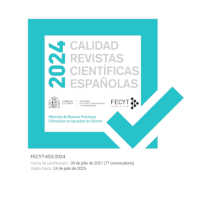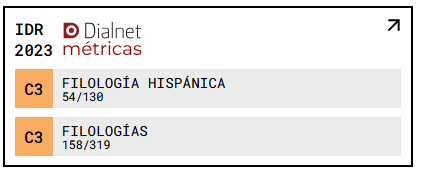Space-time configuration of the medieval female holiness in the “Vida de Santa María Egipciaca”
DOI:
https://doi.org/10.18172/cif.2730Keywords:
space, time, female holiness, repentant prostitute, 13th century, hagiographical poetryAbstract
The shape of space and time in the Vida de Santa María Egipciaca, a 13th century Castilian poem, promotes the textual development of the legend of the repentant prostitute through the dynamics of the initial travel of the sinful and her subsequent penitential stay in the desert for more than forty years, giving priority to the description on the narration when the women reaches the holiness. The female holiness of the desert takes form through ecclesiastical authorization and testimony, represented here by Gozimás and the monks of the Abbey of St. John, real models of the possibility of communitiy Christian life in the period.
Downloads
References
ACOSTA, V. (1996). La humanidad prodigiosa. El imaginario antropológico medieval. Venezuela: Monte Ávila Editores.
CÁRDENAS, A. J. (1995). “The Desert Experience as Other World in the Poem Vida de Santa María Egipciaca”. Romance languages Annual 7: 413-418.
DELGADO, E. E. (2003). “Penitencia y Eucaristía en la conformación de la vertiente occidental de la leyenda de Santa María Egipcíaca: un paradigma de negociación cultural en la Baja Edad Media”. Revista de Poética Medieval 10: 25-55.
GRACIA, P. (2001). “Simbología de las aguas en la Vida de Santa María Egipciaca” en Literatura y cristiandad. Homenaje al profesor Jesús Montoya Martínez. (Eds. Manuel José Alonso García, María Luisa Dañobeitia Fernández y Antonio Rafael Rubio Flores). Granada: Universidad de Granada.
GRIEVE, P. E. (2000). “Paradise Regained in Vida de Santa María Egipcíaca: Harlots, the Fall of Nations and Hagiographic Currency” en Translatio Studii: Essays by his Students in Honor of Karl D. Uitti for his Sixty-Fifth Birthday. (Eds. Renate Blumenfeld-Kosinski, Kevin Brownlee, Mary B. Speer y Lori J. Walters). Amsterdam: Rodopi. DOI: https://doi.org/10.1163/9789004490420_012
LE GOFF, J. (1994). Lo maravilloso y lo cotidiano en el Occidente medieval. Barcelona: Gedisa.
PÉREZ PRIEGO, M. Á. (1984). “Estudio literario de los libros de viajes medievales”. Revista de Filología 1: 217-239. DOI: https://doi.org/10.5944/epos.1.1984.9405
ROBERTSON, D. (1980). “Poem and Spirit. The Twelfth-Century French Life of saint Mary the Egyptian”. Medioevo Romanzo VII (3): 305-327.
ROBERTSON, D. (1987). “Twelfth-Century Literary Experience: The Life of St. Mary the Egyptian”. Pacific Coast Philology 22: 71-77. DOI: https://doi.org/10.2307/1316660
WEISS, J. (2006). The “Mester de Clerecía”: Intellectuals and Ideologies in Thirteenth-Century Castile. Woodbridge: Tamesis. DOI: https://doi.org/10.1515/9781846154935
ZUBILLAGA, C. (2014). Poesía narrativa clerical en su contexto manuscrito. Estudio y edición del Ms. Esc. K-III-4 (“Libro de Apolonio”, “Vida de Santa María Egipciaca”, “Libro de los tres reyes de Oriente”). Buenos Aires: SECRIT. DOI: https://doi.org/10.18002/ehf.v0i37.3256
ZUMTHOR, P. (1994). La medida del mundo. Representación del espacio en la Edad Media. Madrid: Cátedra.
Downloads
Published
How to Cite
Issue
Section
License
The authors retain copyright of articles and authorize CIF the first publication. They are free to share and redistribute the article without obtaining permission from the publisher as long as they give appropriate credit to the editor and the journal.
Self-archiving is allowed too. In fact, it is recommendable to deposit a PDF version of the paper in academic and/or institutional repositories.
It is recommended to include the DOI number.
This journal is licensed under a Creative Commons Attribution 4.0 International License














